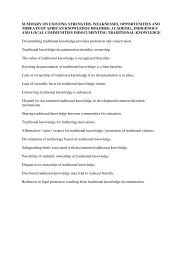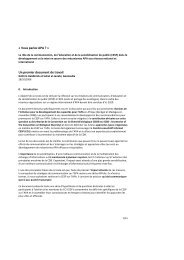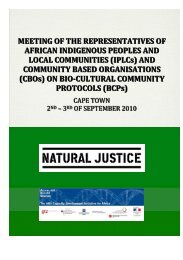From Localized Products to Geographical Indications - Ressources ...
From Localized Products to Geographical Indications - Ressources ...
From Localized Products to Geographical Indications - Ressources ...
You also want an ePaper? Increase the reach of your titles
YUMPU automatically turns print PDFs into web optimized ePapers that Google loves.
Renown is a polymorphous concept that is not easy <strong>to</strong> define. For<br />
some, it means the same as reputation; for others, it has a related but distinct<br />
meaning. The food-processing industry marketing is a case in point.<br />
Always an active exponent of value-adding through market segmentation,<br />
the food processing sec<strong>to</strong>r uses analytical methods <strong>to</strong> bring out the<br />
accepted character of a product by defining its reknown as either ‘spontaneous’,<br />
‘implied’ or ‘supported’. Product reputation, on the other hand, is<br />
directly related <strong>to</strong> what this accepted character implies. The aim is <strong>to</strong> find<br />
out not only whether a product is well known, but also why and how. Such<br />
niceties may well leave you a <strong>to</strong>uch sceptical but they nonetheless form<br />
part of strategically targeted market research. PGI applicants often use<br />
studies of reknown in support of their product’s alleged reputation. These<br />
days, products can become renowned virtually overnight thanks <strong>to</strong> targeted<br />
advertising campaigns that create an illusion of strong cultural<br />
roots. A good example is Aoste ham, Aoste being in fact just a trademark.<br />
Renown and reputation are linked <strong>to</strong> commercial recognition. The<br />
market forces at work in <strong>to</strong>wns and cities will tend <strong>to</strong> highlight certain<br />
products but overlook others – which will remain unknown but continue<br />
<strong>to</strong> exist nonetheless. The relationship between <strong>to</strong>wn and country is a particularly<br />
important fac<strong>to</strong>r when considering the question of renown and<br />
status. <strong>Products</strong> manufactured in scattered villages and hamlets are often<br />
named after the place where they are marketed (for instance, the nearest<br />
<strong>to</strong>wn). Examples are Bayonne ham and Bleu de Sassenage cheese.<br />
Following the tracks<br />
His<strong>to</strong>ry – as a discipline – cannot always account for the his<strong>to</strong>rical<br />
depth of these products because the sources on which that research<br />
depends were sometimes subject <strong>to</strong> the food preferences of the trendsetters<br />
of the time. Which means, of course, that many of these products<br />
will have received little or no mention in the literature. However delicious<br />
a particular cheese or ham, it will remain anonymous if consumption<br />
remains confined <strong>to</strong> the tight-knit community that produces it. Another<br />
problem is that many localized products were originally produced for<br />
domestic consumption within the context of subsistence. All of this<br />
explains why few records have been put down in writing over the centuries,<br />
and why those that do exist tend <strong>to</strong> be somewhat unreliable as a<br />
means of improving our understanding of these products and clarifying<br />
their his<strong>to</strong>rical authenticity. Written records may help <strong>to</strong> place localized<br />
products in a context that makes it easier <strong>to</strong> understand the place they<br />
occupy but cannot always be trusted <strong>to</strong> shed light on the product itself. In<br />
some cases <strong>to</strong>o, the information contained in these ancient records<br />
should be viewed with caution since it may be presented out of context in<br />
order <strong>to</strong> substantiate claims of product anteriority.<br />
23
















